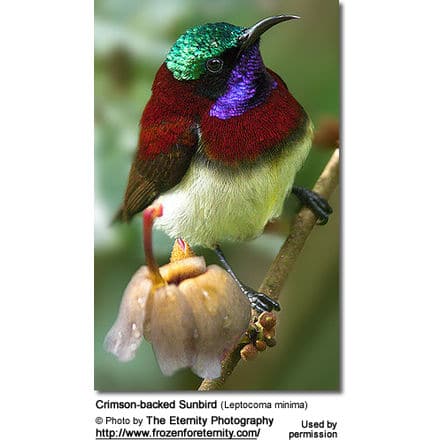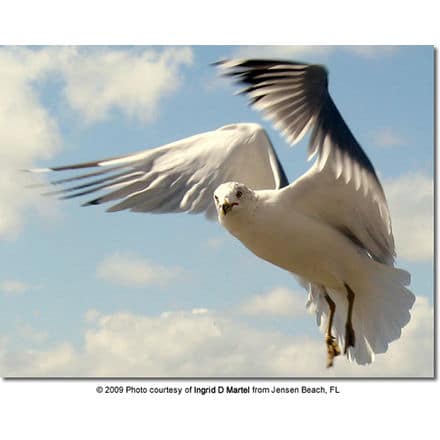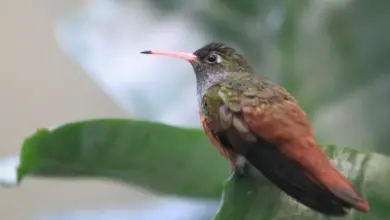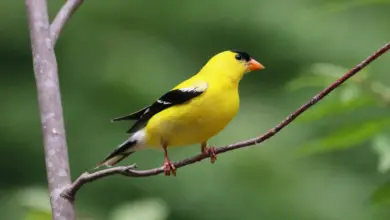Crimson-backed Sunbirds
The Crimson-backed Sunbirds (Leptocoma minima or Cinnyris minima, formerly Nectarinia minima) – also commonly known as the Small Sunbird – is a tiny sunbird that is endemic to southwestern India.
Alternate (Global) Names
French: Souimanga menu; Italian: Nettarinia piccola; German: Däumlingsnektarvogel; Spanish: Suimanga Mínimo; Czech: strdimil trpasli?í; Danish: Dværgsolfugl; Finnish: malabarinmedestäjä; Japanese: mametaiyouchou / ?????????; Dutch: Dwerghoningzuiger; Norwegian: Malabarsolfugl; Polish: nektarnik maly ; Slovak: nektárovka malá; Swedish: Karmosinryggad solfågel
Distribution / Range
The Crimson-backed Sunbird is a permanent resident in the Western Ghats (from north of Mumbai, south to the hills of southern Kerala) in southern India. It is generally common along the Sahyadri Range from Goa to Khandalla; extending often to the adjacent forests. They are rare seasonal visitors in the Belgaum district in the state of Karnataka (southwestern India).
Crimson-backed Sunbirds make altitudinal movements during the rainy season. They may move to the foothills during the monsoons and move higher up during the dry season.
They inhabit a variety of evergreen forests but are most common in flower-rich gardens at the edges of forests or plantations.
These small birds fall victim to numerous predators, including larger birds, praying mantises, and other large insects.
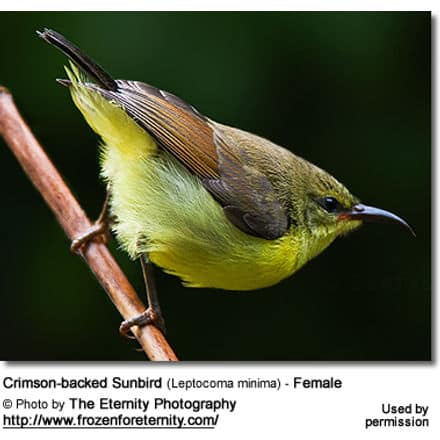
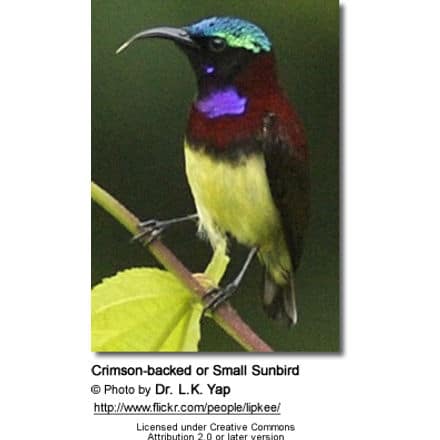
Description
The Crimson-backed Sunbirds are small sunbirds that average 3 inches (~8 cm) in length – including the tail. They have short wings medium-length thin down-curved bills and brush-tipped tubular tongues that allow them to retrieve nectar from tubular-shaped flowers.
Adult male:
Breeding Plumage: His back and upper wing feathers are red. He also has a broad maroon-colored chest band. The underplumage from the chest below is yellowish/whitish. There is a black edge between the red chest band and the pale abdomen. His crown (top of his head) is shiny green. He has pink-violet patches on the throat and rump (immediately above the tail).
Non-breeding (Eclipse) Plumage: There is more olive on his head. The red is restricted to the lower back and wing feathers.
The adult female has an olive-green back and a red rump. Her under plumage is pale yellow and her wings are brown.
Similar Species: The male Crimson-backed Sunbird somewhat resembles the larger Purple-rumped Sunbird, but doesn’t have the bright shoulder patches and white flanks of that species. The female Crimson-backed looks similar to the female Purple-rumped, except for her red rump.
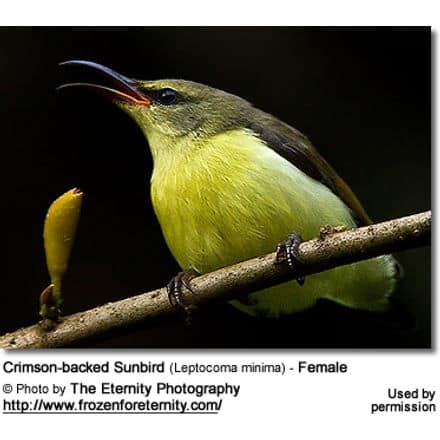
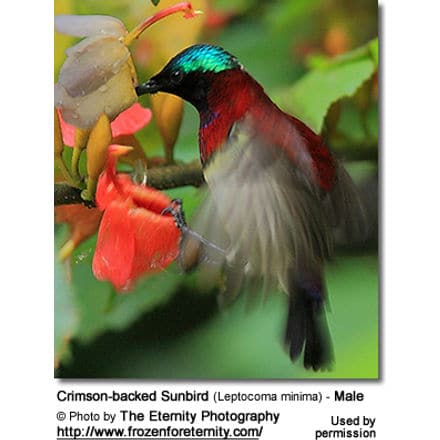
Diet / Feeding
Crimson-backed Sunbirds mostly feed on nectar, although take insects, particularly during the breeding season to feed their young and to satisfy their own need for increased protein in their diet during this demanding time.
They favor flowers with the highest sugar content and seek out those areas containing flowers with high-energy nectar.
Even though most sunbirds can take nectar by hovering like a hummingbird, the Crimson-backed Sunbirds usually perch while taking nectar
The males establish feeding territories on flower-bearing shrubs and trees, which they aggressively defend.
Many native and cultivated plants on whose flowers sunbirds feed heavily rely on them for pollination. The mostly tubular-shaped flowers exclude most bees and butterflies from feeding on them and, subsequently, from pollinating the plants.
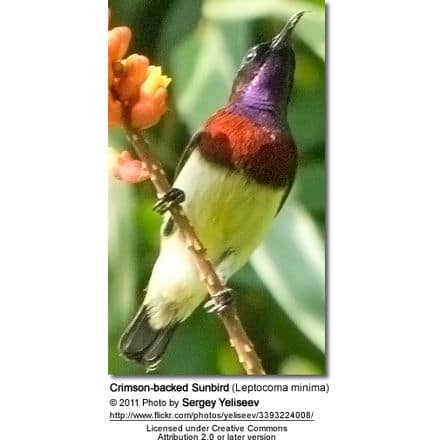
Breeding / Nesting
The Crimson-backed Sunbirds mostly breed in December through March – but may nest nearly throughout the year in the southern Western Ghats.
The male and female build the purse-shaped, moss-covered nest together – although the female takes on the part of lining the nest. The nest is often suspended from the underside of large fern fronds, or thin branches of a low tree or shrub.
The average clutch consists of 2 eggs which are mostly incubated by the female for about 18 – 19 days. The male assists with feeding the young.
Calls / Vocalizations
Their calls include short chik calls and longer chee-chee-which-chee.
